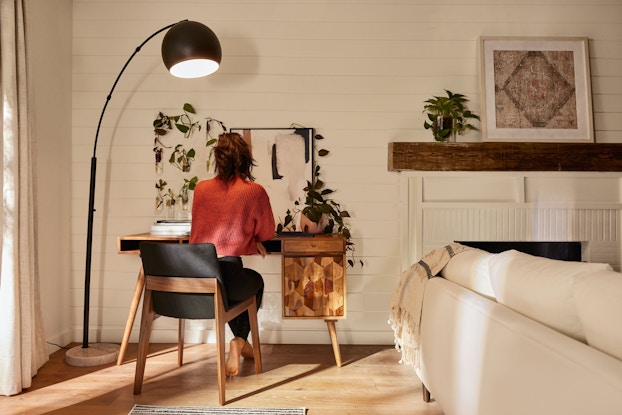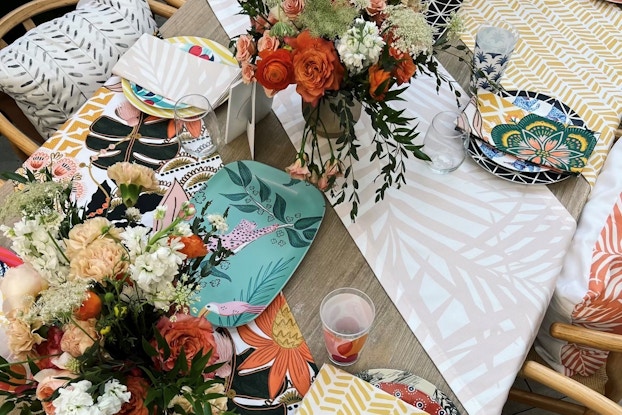
How Shutterfly, Lands’ End, and Fernish tapped the work-from-home trend for growth:
- The surge in remote work prompted furniture rental startup Fernish to enter the home office furnishings space, which now accounts for 15% of its business.
- Lands’ End’s pandemic-launched ‘Let’s Get Comfy’ campaign, which plays up comfortable fabrics in casual fare to business looks, is resonating with shoppers even as they return to the office on a hybrid work basis.
- Shutterfly’s expansion into home products with a personalized, ‘style it yourself’ twist is driving up average order values for the company.
The pandemic created a new breed of homebodies.
Amid the COVID-fueled, shape-shifting remote-work trend, consumers’ lives at home, which now often double as their office space, have taken center stage like never before.

Interested in a small business membership?
Find out how the U.S. Chamber of Commerce can help your company grow and thrive in today's rapidly-evolving business environment. Connect with our team to learn how a small business membership can benefit your bottom line and help you achieve your goals.
The lifestyle pivot is also influencing how we dress, as quarantine-donned comfort wear makes an imprint on consumers’ wardrobes more than two years after the pandemic upended daily life as we know it.
As the shift laid bare new business opportunities, apparel brand Lands’ End, photo-sharing site Shutterfly, and furniture disruptor Fernish seized on the demands of the post-COVID consumer landscape. Their moves paid off: The surge in remote work nudged Fernish into office furnishings, which now accounts for 15% of its business; Shutterfly’s expansion into personalized home products is driving up average order values; and by leaning into casual apparel with its “Let’s Get Comfy” push, Lands’ End has hit on a trend that’s resonating even as consumers make their hybrid-scheduled office return, executives from the brands told CO—.
The ‘comfort-meets-self-care’ equation
Today you’d be hard pressed to find a business that’s mandating workers to return to the office more than three times a week, said Jane Hali, Founder of investment research and retail/brand consulting firm Jane Hali & Associates.
So, the post-pandemic shift to “comfort dressing,” like leggings and joggers, marks a “long-term consumer change” that coincides with the rise of outerwear (think hoodies and fleece blazers.)
“This is a structural change from the pandemic — [activities such as] walking, running, camping, fishing, have all become a new lifestyle that is not going away,” she said.
At the same time, “A precarious world is causing consumers to transform their homes into fortresses that provide comfort, resilience, and a low-impact lifestyle,” Thomas Klaffke, Head of Research for trend forecasting firm TrendWatching, told CO—. “Comfort means that self-care has converged with home-care, opening up a myriad of opportunities for brands to tap into consumers’ new, increasingly home-centered approaches to personal care,” Klaffke said.
Comfort means that self-care has converged with home-care, opening up a myriad of opportunities for brands to tap into consumers’ new, increasingly home-centered approaches to personal care.Thomas Klaffke, Head of Research, TrendWatching
Fernish: Work-from-home trend prompts launch of office furniture business, now 15% of sales
When the pandemic took hold, furniture rental startup Fernish found itself fielding an influx of requests for home office furniture seemingly overnight, from desks and lamps to office chairs and bookshelves, said Michael Barlow, Founder and CEO. Customer demand for home décor spiked too, as consumers were of the mind, “‘My space has to feel homier and give off an amazing, positive energy to spend a lot more time there than I ever was,’” he said.
It's then Barlow realized: “I have to figure out a strategy around work from home. Pre-pandemic, Fernish was squarely focused on “living, dining, and bedroom” furnishings, he said.
The startup dove into the trend, building out its mix of items like standing desks and office chairs.
Fernish also added more easily assembled modular furniture that can be combined in different ways to adjust to different spaces, leaning into the pandemic-fueled uptick in folks “relocating from one market to another,” he said.

That demand came as the pandemic put the already ascendant furniture-as-a-service trend — whereby home goods are rented or leased— on steroids, according to a Jefferies report. “Furniture-as-a-service is poised to grow significantly in the years ahead,” the report said.
The trend answers the desire among consumers, particularly millennials and Gen Z who move more frequently than older demographic groups, for short-term-commitment home furnishings that incur minimal upfront costs, without compromising style and quality, the report says.
Barlow has shifted Fernish’s messaging accordingly. Its marketing now speaks to how “we can service you and your lifestyle with furniture that changes with you and your different circumstances — whether it be a different space, a different city, or a different job,” he said.
As a result, “Work-from-home furniture went from zero percent of the business to 15% today,” Barlow said.
[Read: Secondhand Surge: Inflation, Product Scarcity, and New Tech Platforms Fuel Resale Market]

Lands’ End: ‘Comfy’ clothing push woos shoppers amid ‘all the twists and turns of our new normal’
At the onset of the pandemic, Lands’ End accelerated the launch of its “Let’s Get Comfy” campaign, which had been planned for Fall 2020. “We had previously recognized a general trend towards casualization of dress, and it took hold to a much greater degree as more people began to work and play from home,” Matt Trainor, SVP, Global Brand Creative and Marketing, told CO—.
It was the right decision that’s still paying dividends for the brand, as the campaign still resonates with shoppers, he said.
And “as our customers start to return to the office and other pre-pandemic activities, they continue to favor comfort — whether casual or more formal business wear. It’s because of this demand that we’ve leaned into the belief that this trend is here to stay.”

Indeed, “versatility” and “comfort” rank as top product attributes when shopping, according to Lands’ End’s customer insights, Trainor said.
“For us, ‘comfy’ doesn’t just mean sweatpants; it means softer, stronger fabrics that transition and layer from one look to the next,” Trainor said. “It’s about versatility and knowing you can count on everything in your closet to be appropriate for all the twists and turns of our new normal. And it’s also the right rain coat or winter boot that keeps you warm and dry; swimwear that boasts UPF 50 protection, sizes that fit every body type.”
Lands’ End, Trainor says, is well positioned to capitalize on “consumers’ new type of comfortable-yet-pulled-together style.”
[Read: Retailers Turn Pandemic-Fueled Self-Care and WFH Trends Into Business Opportunities]

Shutterfly expansion into personalization home products drives up average order values
Last year, photo-sharing site Shutterfly acquired Spoonflower, a global marketplace for custom artist-created wallpaper, fabric, and home décor.
The acquisition was well timed, as consumers’ appetite for home goods with a one-of-a-kind sheen grew amid the pandemic, Hilary Schneider, CEO of Shutterfly, told CO—. More than ever, “They want to curate and select what goes in their home.”
Today, 80% of consumers want to buy something personalized, she said, citing Epsilon research.
Leaning into the trend, Shutterfly is leveraging Spoonflower to exponentially up its ability to offer personalization via an array of home goods that can now be customized by 4,000 designs sourced from 600 Spoonflower independent artists.
The brand is putting its own spin on personalized goods by diving into the self-coined “style it yourself” (SIY) trend, Schneider said. Indeed, Shutterfly found that 85% of Americans want a hand in creating personalized home decor and gift items but would rather pluck from curated designs versus making things themselves via DIY projects, according to a Wakefield Research/Shutterfly survey.

“[‘Style it yourself’] gives you as the consumer the ability to design [merchandise] for yourself or as gifts for others,” Schneider said. So, instead of buying a set of plates, one can curate their own idiosyncratic mix-and-match set by tapping thousands of design options.
For Shutterfly, the move “widens the use case and expands the [business’s] total addressable market,” she said. “With Spoonflower fully integrated into Shutterfly’s family of brands, we are expanding the brand’s reach past photo personalization and positioning Shutterfly as a premier destination for stylized self-expression.
Today, custom designed products are “disproportionately” drawing new customers to Shutterfly, Schneider said. They are also driving up frequency of purchase rates as well as the average order value of a sale. “The average order value when someone buys customized products is higher than when buying non-customized products,” she said. For example, instead of a customer buying one plate with a photo of their son, “they’re buying eight plates.”
CO— aims to bring you inspiration from leading respected experts. However, before making any business decision, you should consult a professional who can advise you based on your individual situation.
Follow us on Instagram for more expert tips & business owners’ stories.
CO—is committed to helping you start, run and grow your small business. Learn more about the benefits of small business membership in the U.S. Chamber of Commerce, here.







